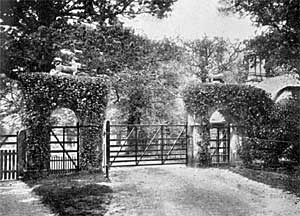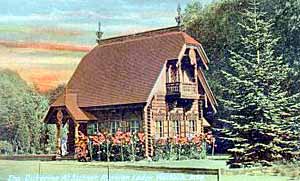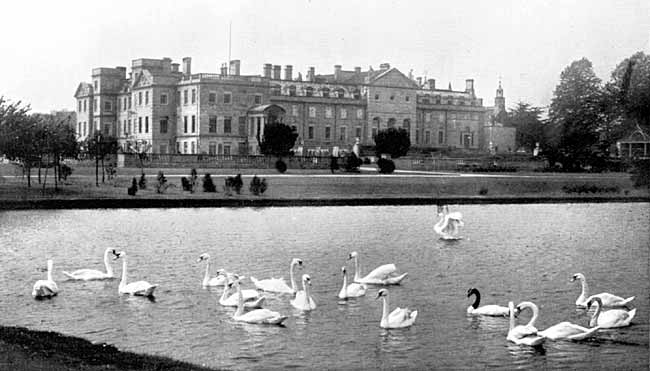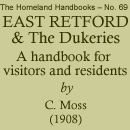< Previous | Contents | Next >

Buck Gates, Thoresby c.1910.
In less than a couple of miles we reach Buck Gates, so named from the two stone figures of bucks on the piers, and, passing through, we enter that portion of Sherwood Forest known as Bilhagh, the property of Earl Manvers. We are now in the very heart of' Merrie Sherwoode," the country of the bold, if mythical, Robin Hood, the gentle outlaw of noble descent, who stole from the rich to give to the poor, who held sheriffs in huge disdain, and lived a jolly life under the greenwood tree. In Bilhagh we are near to Edwinstowe, the halfway house. Here we alight, and walk one hundred yards or so into the forest, and there, in an open glade, come to the celebrated Major Oak. This monarch of the woods, probably a thousand years old, measures over thirty feet in circumference five feet up the trunk; it spreads therefrom 240 feet in a straight line, and the circumference of its branches is nearly 270 yards. Despite its wealth of foliage the tree is hollow, with room enough for a dozen persons. It is, of course, only one leviathan amongst others. This may or not be the "forest primeval," but it certainly remains much the same as it was in the days of the Saxons. We are in an open glade in the centre of the woodlands; the surroundings are the handiwork of nature, and to the dwellers in towns the change will be as welcome as it is complete.
Leaving the Major Oak we saunter for about a mile or less into Edwinstowe village. Here in the large and comfortable room of the Royal Oak we sit down to dinner. After dinner there is time for a peep round the village and into Edwinstowe Church, which is dedicated to St. Mary, and dates from Norman times. [It is open daily from nine o'clock to dusk.] The south wall bears the date "1833," apparently that of its restoration. The tower up to and including the belfry, which contains six bells, was commenced early in the thirteenth century and completed in the fourteenth. It is sound, but in need of repair. The octagonal spire, nearly two hundred feet high, is decayed. A movement for the restoration of both tower and spire has been set on foot. The roofs are embattled. There are nave, aisles, and chancel. The nave is divided from the aisles by arcades of four bays supporting a clerestory lighted by ten windows.
We depart from Edwinstowe with regret. Cheerily bowling along for Welbeck, we leave Clipstone a little on the left. Here was an ancient house, which was inhabited by the kings of Northumbria before the Conquest. King John frequently resided at Clipstone, both whilst Earl of Mortain, and after his accession to the throne, and here are the ruins of King John's Palace. At Clipstone originated that diabolical deed which of itself alone renders King John infamous. While hunting here, a messenger arrived from his sister Joan, who had married Llewellyn, Prince of Wales, with tidings of a renewed Welsh revolt. In answer to his summons, the barons and other distinguished personages, either of his retinue or housed in the palace, assembled under an oak tree, afterwards called "Parliament Oak," which still remains. In a towering rage King John demanded their consent to the execution of twenty-eight Welsh hostages then detained by his orders in Nottingham Castle. To this monstrous request they agreed. Accompanied by his attendants King John rode to Nottingham, called for the castle governor and announced his intention. These youthful sons of Welsh nobles, some mere boys, were called from their amusements in the castle grounds, seized, bound, and, while uttering heartrending cries, were all hanged in a row. King John then returned to Clipstone to dine. A parliament was also held at Clipstone by Edward I in 1290, but whether under the oak or in the palace is uncertain.

Russian log cottage, Birklands.
We now enter that portion of Sherwood Forest called The Birkland. Attention is directed to the rustic Russian log cottage, used by the Duke of Portland during the season as a shooting-box, said to have been put together without the use of nails. Presently we reach the famous oak tree designated "Robin Hood's Larder," where Robin is supposed to have hung his venison and other kinds of game. As we penetrate The Birkland, the glory of Sherwood Forest is continued and, if possible, intensified. The grand old oaks, gnarled and rugged and knotted, fling their branches broad and high, robed with an amplitude of exquisite foliage; they grip the soil and cling to it with marvellous vitality; they laugh in defiance of the storms of winter—true and brave like the race by whom they are honoured and beloved. Here the silver birch adds elegance and grace ; there the mighty beech, in its wonderful vesture of green and gold, sheds warmth and glow, The scene is one of indescribable beauty, gradually unfolding until the consummation is reached in Welbeck Park, where deer and cattle and sheep are grazing in thousands, and in Welbeck Abbey, the seat of his Grace the Duke of Portland, P.C., G.C.V.O., D.L., J.P., in all its magnificent stateliness. Here the "Greendale Oak," of a fabulous age, was cut through in 1724, and a coach road made, the aperture being 10ft. 3 in. high, 6ft. 3m. wide, and its circumference above the arch 35ft. 3 in. The Earl of Oxford, who saw the tree shortly after it was cut, and drove through it, wrote, "There were several of the most heavy and cumbersome branches cut off at the same time to ease the tree, but there are still reckoned to be about nine tons of timber remaining upon it." There are other gigantic trees in the park, which are noted and named. The lake, which includes several fine sheets of water, is upwards of four miles in length; the gardens are of great extent and beauty, and the park abounds with deer. At the Abbey the team is put up, and about a couple of hours is allowed for inspection.

WELBECK ABBEY. The Seat of the Duke of Portland.
Welbeck Abbey is said to have been founded by Thomas de Cukeney, son of Lord de Cukeney, for Praemonstratensian canons in Leicestershire. He began it in the reign of Stephen (1135-54) and completed it in that of Henry II. (1154-89). It was liberally endowed by the founder, and further enriched by the magnificent bequests of Sir Henry de Fauconberg in 1329, and of other benefactors, so that it became one of the wealthiest abbeys in England. Welbeck indeed grew to be the gardens and pleasure grounds are also open to the visitors.
The delightful ramble over, we resume our seats, plunge into the gloomy depth of Welbeck tunnel, and emerge on the Worksop road. At Worksop, a busy, thriving town, we pull up for tea, then rattle down Park Street, away to the village of Manton, where the Wigan Coal and Iron Co. have sunk a new coal pit, which is now in active operation; under the Great Central Railway, and on to Scofton-with-Osberton, a well wooded and picturesque township. The church is modern, but the communion plate, consisting of large silver flagon, chalice and paten, dates from the time of George III.
From Scofton we bowl through the hamlets of Morton and Ranby, along the "straight mile," down the hill to the Babworth post office, where we made the detour in the morning, and so return to Retford, after a pleasant, wonderfully-varied drive of fully thirty-five miles.
